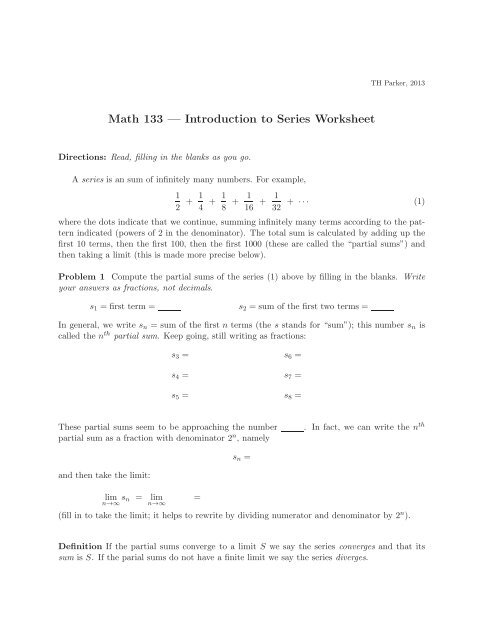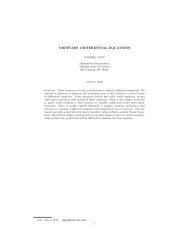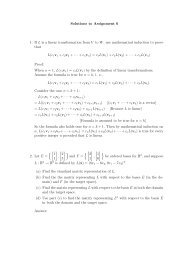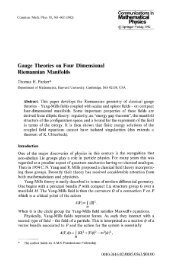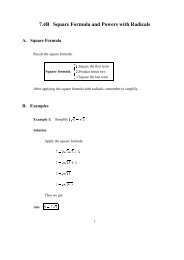Math 133 — Introduction to Series Worksheet
Math 133 — Introduction to Series Worksheet
Math 133 — Introduction to Series Worksheet
You also want an ePaper? Increase the reach of your titles
YUMPU automatically turns print PDFs into web optimized ePapers that Google loves.
<strong>Math</strong> <strong>133</strong> <strong>—</strong> <strong>Introduction</strong> <strong>to</strong> <strong>Series</strong> <strong>Worksheet</strong><br />
Directions: Read, filling in the blanks as you go.<br />
A series is an sum of infinitely many numbers. For example,<br />
1<br />
2<br />
+ 1<br />
4<br />
+ 1<br />
8<br />
+ 1<br />
16<br />
+ 1<br />
32<br />
TH Parker, 2013<br />
+ ··· (1)<br />
where the dots indicate that we continue, summing infinitely many terms according <strong>to</strong> the pattern<br />
indicated (powers of 2 in the denomina<strong>to</strong>r). The <strong>to</strong>tal sum is calculated by adding up the<br />
first 10 terms, then the first 100, then the first 1000 (these are called the “partial sums”) and<br />
then taking a limit (this is made more precise below).<br />
Problem 1 Compute the partial sums of the series (1) above by filling in the blanks. Write<br />
your answers as fractions, not decimals.<br />
s1 = first term = s2 = sum of the first two terms =<br />
In general, we write sn = sum of the first n terms (the s stands for “sum”); this number sn is<br />
called the n th partial sum. Keep going, still writing as fractions:<br />
s3 = s6 =<br />
s4 = s7 =<br />
s5 = s8 =<br />
These partial sums seem <strong>to</strong> be approaching the number . In fact, we can write the n th<br />
partial sum as a fraction with denomina<strong>to</strong>r 2 n , namely<br />
and then take the limit:<br />
lim<br />
n→∞ sn = lim<br />
n→∞<br />
=<br />
sn =<br />
(fill in <strong>to</strong> take the limit; it helps <strong>to</strong> rewrite by dividing numera<strong>to</strong>r and denomina<strong>to</strong>r by 2 n ).<br />
Definition If the partial sums converge <strong>to</strong> a limit S we say the series converges and that its<br />
sum is S. If the parial sums do not have a finite limit we say the series diverges.
Problem 2 Consider the series<br />
2<br />
5<br />
+ 2<br />
25<br />
+ 2<br />
125<br />
+ 2<br />
625<br />
+ ··· (2)<br />
(the denomina<strong>to</strong>rs are powers of 5). Write the partial sums in the form 1<br />
−(something) and,<br />
2<br />
based on the pattern, guess a formula for sn:<br />
s1 = 2<br />
5<br />
= 1<br />
2 − 10<br />
s2 = 2 2<br />
+<br />
5 25 = 25<br />
s3 = 2<br />
5<br />
+ 2<br />
25<br />
Since lim<br />
n→∞ sn = lim<br />
n→∞<br />
Problem 3 For the series<br />
= 1<br />
2 − 50<br />
+ 2<br />
125 = 125<br />
= 1<br />
2 −<br />
s4 = = 1<br />
2 −<br />
sn =<br />
1<br />
− = , the series (2) converges and its sum is S = .<br />
2<br />
1<br />
17<br />
+ 1<br />
17<br />
+ 1<br />
17<br />
+ 1<br />
17<br />
+ 1<br />
17<br />
(all terms are the same) the n th partial sum is sn = . Because<br />
lim<br />
n→∞ sn = lim<br />
n→∞<br />
the series (3) converges/ diverges (circle one).<br />
+ ··· (3)<br />
= ,<br />
Problem 4 For each wholenumbernwecan findanothernumbern!(pronounced“nfac<strong>to</strong>rial”)<br />
by multiplying <strong>to</strong>gether all the whole numbers up <strong>to</strong> n:<br />
Using a calcula<strong>to</strong>r, find these fac<strong>to</strong>rials:<br />
n! = 1·2·3·4···n<br />
2! = 1·2 = 5! = 8! =<br />
3! = 1·2·3 = 6! = 9! =<br />
4! = 1·2·3·4 = 7! = 10! =
Problem 5 Now consider the series<br />
1 + 1 + 1<br />
2!<br />
+ 1<br />
3!<br />
+ 1<br />
4!<br />
+ 1<br />
5!<br />
+ 1<br />
6!<br />
+ ··· (4)<br />
Using a calcula<strong>to</strong>r, write down the partial sums as decimals (record 6 digits after the decimal<br />
point):<br />
s3 = s6 = s9 =<br />
s4 = s7 = s10 =<br />
s5 = s8 = s11 =<br />
The series (4) seems <strong>to</strong> converge and the sum appears <strong>to</strong> be the number S =<br />
(the number s11 is very close <strong>to</strong> what famous number?).<br />
Problem 6 Now modify the series in the previous problem by making the signs alternate:<br />
1 − 1 + 1<br />
2!<br />
− 1<br />
3!<br />
+ 1<br />
4!<br />
− 1<br />
5!<br />
+ 1<br />
6!<br />
− ··· (5)<br />
Again, using a calcula<strong>to</strong>r, write down the partial sums as decimals (record 6 digits after the<br />
decimal point):<br />
s3 = s6 = s9 =<br />
s4 = s7 = s10 =<br />
s5 = s8 = s11 =<br />
Compare these partial sums <strong>to</strong> the numbers (use your calcula<strong>to</strong>r and write down 6 decimal<br />
places):<br />
e = and<br />
1<br />
e =<br />
The series (5) seems <strong>to</strong> converge and the sum appears <strong>to</strong> be S = .<br />
Problem 7 Consider the series<br />
2 2 2 2 2<br />
+ + + + +<br />
1·3 1 3·3 3 5·3 5 7·3 7 9·3 9<br />
2<br />
+ ··· (6)<br />
11·3 11<br />
whose numera<strong>to</strong>r is always 2 and the denomina<strong>to</strong>rs are successive odd numbers times the same
odd power of 3. This series converges. As before, write the partial sums as decimals <strong>to</strong> 6 places.<br />
S<strong>to</strong>p when you reach a partial sum that is equal <strong>to</strong> the number ln2 = <strong>to</strong> 6 decimal<br />
places.<br />
s1 = s4 = s7 =<br />
s2 = s5 = s8 =<br />
s3 = s6 = s9 =<br />
Problem 8 A famous series is the harmonic series<br />
1 + 1<br />
2<br />
+ 1<br />
3<br />
+ 1<br />
4<br />
+ 1<br />
5<br />
+ 1<br />
6<br />
(a) Use a calcula<strong>to</strong>r <strong>to</strong> find the sum s10 of the first 10 terms.<br />
(b) Go <strong>to</strong> WolframAlpha.com and type in the words<br />
the sum from n=1 <strong>to</strong> n=10 of 1/n<br />
Is that what you got?<br />
1<br />
+ ··· (7)<br />
7<br />
(c) Make a table showing s10,s20,s50,s100 <strong>to</strong> 2 decimal places (e.g. 5.27). Then do some more.<br />
(d) Does the harmonic series converge?<br />
Problem 9 Repeat the above steps for the alternating harmonic series<br />
1 − 1<br />
2<br />
+ 1<br />
3<br />
− 1<br />
4<br />
+ 1<br />
5<br />
− 1<br />
6<br />
(a) Again use a calcula<strong>to</strong>r <strong>to</strong> find the sum s10 of the first 10 terms.<br />
(b) Check your answer on WolframAlpha.com <strong>—</strong> enter<br />
the sum from n=1 <strong>to</strong> n=10 of (-1)^n*1/n<br />
1<br />
+ ··· (8)<br />
7<br />
(c) Again make a table showing s10,s20,s50,s100 <strong>to</strong> 2 decimal places and beyond.<br />
(d) Does the alternating harmonic series converge?


